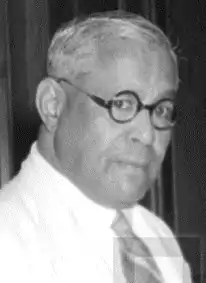John Matthai
John Matthai CIE (1886-1959) was an economist who served as India's first Railway Minister and subsequently as India's Finance Minister,[1] taking office shortly after the presentation of India's first Budget, in 1948. Matthai was born into an marthoma family and graduated in economics from the University of Madras. He served as a Professor and Head in University of Madras from 1922 to 1925.[2] He presented two Budgets as India's Finance Minister, but resigned following the 1950 Budget in protest against the increasing power of the Planning Commission and P. C. Mahalanobis.[3][4] He was the first Chairman of the State Bank of India when it was set up in 1955. He was the founding President of the Governing Body of the National Council of Applied Economic Research (NCAER) in New Delhi, India's first independent economic policy institute established in 1956. He served as the Vice Chancellor of the University of Mumbai from 1955 till 1957[5] and then as the first Vice Chancellor of the University of Kerala from 1957 to 1959. His nephew, Verghese Kurien, is generally recognized as the architect of India's White Revolution.[6] Dr. John Matthai Centre,[7] Thrissur, located on the large plot of land donated by his family, is named in his honour. His wife, Achamma Matthai was an Indian social worker and a women's rights activist.[8] The Government of India honoured her in 1954 with the award of Padma Shri, the fourth highest Indian civilian award, for her contributions to the society,[9]
John Matthai | |
|---|---|
 John Matthai in 1949 | |
| Minister of Finance | |
| In office 22 September 1948 – 1 June 1950 | |
| Prime Minister | Jawaharlal Nehru |
| Preceded by | R. K. Shanmukham Chetty |
| Succeeded by | C. D. Deshmukh |
| Minister of Railways | |
| In office 15 August 1947 – 22 September 1948 | |
| Prime Minister | Jawaharlal Nehru |
| Preceded by | Inaugural Holder |
| Succeeded by | N. Gopalaswami Ayyangar |
| Personal details | |
| Born | 10 January 1886 Calicut, Madras Presidency, British India (now Kozhikode, Kerala, India) |
| Died | February 1959 (aged 73) |
| Nationality | British Indian (1886-1947) Indian (1947-59) |
| Political party | Indian National Congress |
| Alma mater | Madras Christian College |
John Matthai was invested as a Companion of the Order of the Indian Empire (CIE) in 1934,[10] and was awarded the Padma Vibhushan in 1959.[11] NCAER, led by the President of its Governing Body, Nandan Nilekani and with support from the Nilekani Philanthropies, honoured John Matthai in 2019 by naming NCAER's new office building at its campus in New Delhi as the John Matthai Tower.
References
- Reflections on Finance Education and Society. Motilal Banarsidass Publication. p. 114. ISBN 9788120830752. Retrieved 22 July 2009.
- "Archived copy". Archived from the original on 29 October 2008. Retrieved 23 January 2009.CS1 maint: archived copy as title (link)
- "Men who shaped up India's economy". The Economic Times. 21 February 2007. Retrieved 4 April 2019.
- "The Concept of Collective Ministerial Responsibility in India- Theory and Practice". Rostrum's Law Review. 2 January 2014. Retrieved 4 April 2019.
- Matthai, John (1957). "A Message By the Vice-Chancellor". The Bombay Technologist. 7 (1). ISSN 0067-9925. Retrieved 12 June 2020.
- "The Nephew Of Our First Railway Minister Was The Architect Of 'White Revolution'". The Logical Indian. 14 June 2016. Retrieved 4 April 2019.
- "Dr. John Matthai Centre". www.jmctsr.org. Retrieved 4 April 2019.
- Bela Rani Sharma (1998). Women's Rights and World Development. Sarup & Sons. ISBN 9788176250153. Retrieved 31 March 2015.
- "Padma Shri" (PDF). Padma Shri. 2015. Archived from the original (PDF) on 15 November 2014. Retrieved 11 November 2014.
- London Gazette, 4 June 1934
- "Padma Vibhushan Awardees". The National Portal of India. Archived from the original on 29 February 2012. Retrieved 10 July 2009.
External links
| Preceded by R. K. Shanmukham Chetty |
Finance Minister of India 1949–1951 |
Succeeded by Chintamanrao Deshmukh |